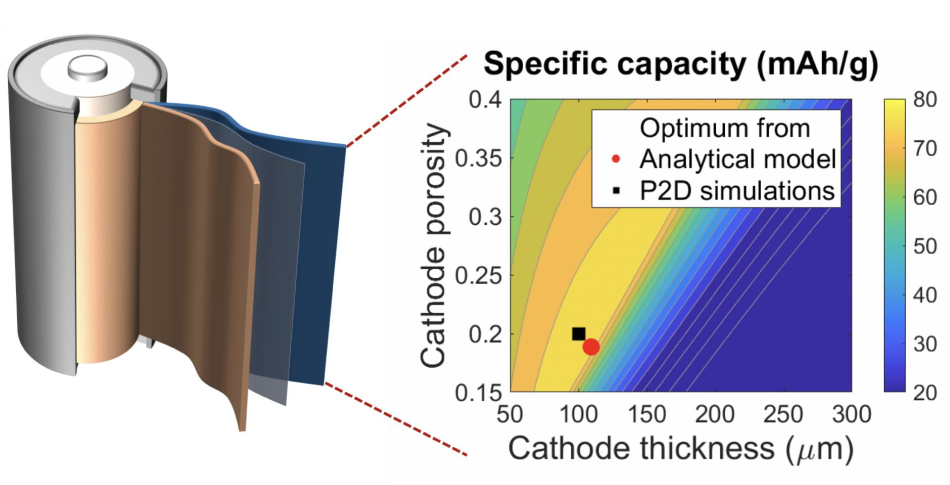Sep 17 2020
According to engineers from Rice University, a simpler and more efficient method to estimate performance will result in more improved batteries.
 A graph that maps the capacity of batteries to cathode thickness and porosity shows a laborious search based on numerical simulations (black square) and a new Rice University algorithm (red dot) return nearly the same result. Rice researchers say their calculations are at least 100,000 times faster. Image Credit: Illustration by Fan Wang.
A graph that maps the capacity of batteries to cathode thickness and porosity shows a laborious search based on numerical simulations (black square) and a new Rice University algorithm (red dot) return nearly the same result. Rice researchers say their calculations are at least 100,000 times faster. Image Credit: Illustration by Fan Wang.
The fact that the latest technique is 100,000 times faster than present-day modeling methods is an added advantage.
The analytical model, which was designed by materials scientist Ming Tang and graduate student Fan Wang from Rice University’s Brown School of Engineering, does not need complicated numerical simulation to guide the design and selection of battery components and the way they interact.
Designed at Rice University, the streamlined model can be freely accessed online. It does the heavy lifting with a precision of less than 10% of more computationally intensive algorithms. According to Tang, the model will enable scientists to rapidly assess the rate capability of batteries powering the planet.
The study results appeared in Cell Reports Physical Science, an open-access journal.
According to Tang, there was a clear requirement for the updated model.
Almost everyone who designs and optimizes battery cells uses a well-established approach called P2D (for pseudo-two dimensional) simulations, which are expensive to run. This especially becomes a problem if you want to optimize battery cells, because they have many variables and parameters that need to be carefully tuned to maximize the performance.
Ming Tang, Materials Scientist, Rice University
Tang continued, “What motivated this work is our realization that we need a faster, more transparent tool to accelerate the design process, and offer simple, clear insights that are not always easy to obtain from numerical simulations.”
Battery optimization usually includes a so-called “perpetual trade-off” between power density (the speed of its discharge) and energy (the quantity it can store), all of which rely on the materials, their configurations, and also internal structures such as porosity.
There are quite a few adjustable parameters associated with the structure that you need to optimize. Typically, you need to make tens of thousands of calculations and sometimes more to search the parameter space and find the best combination. It’s not impossible, but it takes a really long time.
Ming Tang, Materials Scientist, Rice University
Tang added that the new model can be easily applied to standard software, such as Excel and MATLAB, and even to calculators.
To verify the new model, the team allowed it to look for the optimal thickness and porosity of an electrode in standard half- and full-cell batteries. During the process, the researchers found that electrodes with “uniform reaction” behavior, such as nickel-cobalt-aluminum oxide and nickel-manganese-cobalt, are best for applications, where thick electrodes are required to boost the energy density.
The team also found that battery half-cells (with just a single electrode) have innately better rate capacity, which means their performance is not a consistent indicator of how electrodes will function in the full cells utilized in commercial batteries.
The research work is associated with Tang laboratory’s attempts at interpreting and improving the link between the performance and microstructure of battery electrodes, the topic of many recent articles that demonstrated how defects in cathodes can expedite the absorption of lithium and how lithium cells can be pushed too far in the search for speed.
Tang is also an assistant professor of materials science and nanoengineering. The study was funded by the U.S. Department of Energy.
Journal Reference:
Wang F & Tang, M (2020) A Quantitative Analytical Model for Predicting and Optimizing the Rate Performance of Battery Cells. Cell Reports Physical Science. doi.org/10.1016/j.xcrp.2020.100192.